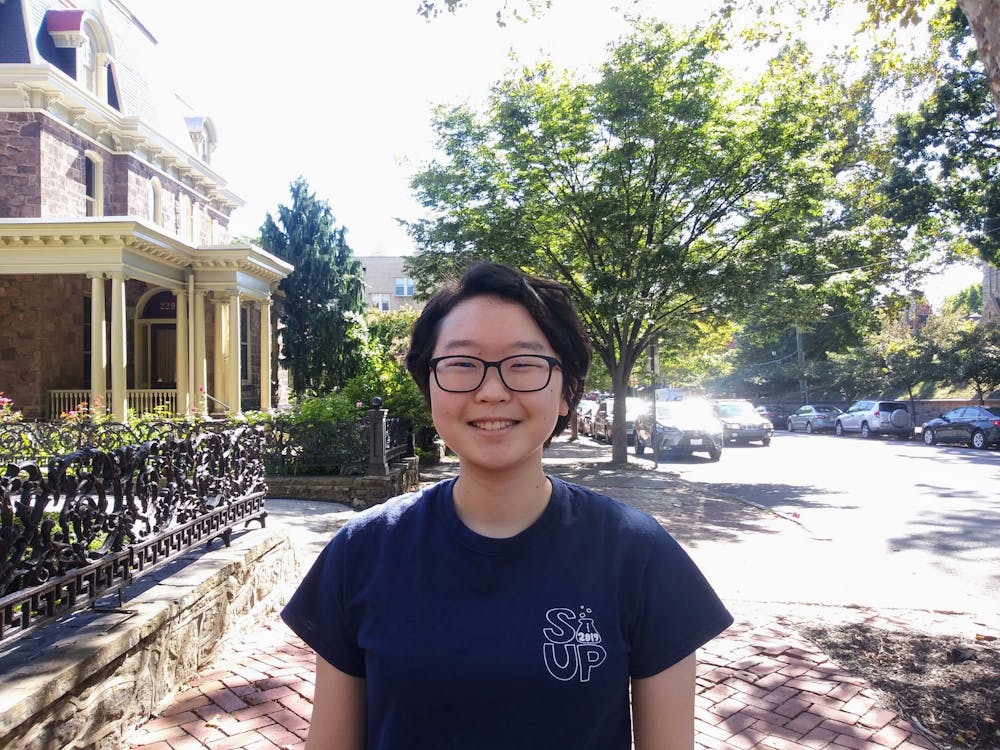After snoozing your alarm three times, you roll out of bed in a rush, throw on a pair of pants you picked up from the floor, and weave your way through the throng of students on Locust heading to their 10:15 classes. Students like Christina Kim (E ‘22), however, don’t have this luxury—she regularly had to wake up at 5:45 a.m. to get to campus on time.
Commuting from her family home in Northern Delaware, Christina took a SEPTA Regional Rail train each morning, which averaged 60 to 70 minutes per trip. On nights when her a cappella group rehearsed, she’d take the 9 p.m. train back and wouldn’t get home until 11.
Christina made this trip daily during the fall semester of her sophomore year, as well as the previous summer, when she was working in a lab on campus full–time. Her busy schedule and the chronic sleep deprivation eventually became too much and she stopped commuting.
When Christina was living with her parents, she’d make the trek with her older sister, then a Master’s student at Penn. She was supposed to live on campus that fall, but her sister’s graduate school was more expensive than her family expected, so they both lived at home to cut back on costs.
“It was purely financial,” Christina says. For the spring semester, she and her sister moved back to Philadelphia into a relatively inexpensive sublet.
The commuter population at Penn is much smaller than other nearby schools, such as Temple University or Chestnut Hill College, largely because the campus was designed to be residential. Commuting certainly comes with challenges, like being away from home for more than 12 consecutive hours a day, or delays on an already long train ride. Students who live on–campus can stop by their rooms or crash on the couch during breaks between classes, but commuters don’t have the same luxury.
Still, there are students who do it from within a few miles of campus to across state lines, primarily because of financial reasons—although your parents’ homemade cooking is certainly a plus. Sometimes, the difficulties of commuting vastly outweigh the benefits, but experiences vary drastically, especially based on how far and how long you’re traveling.
While you check the train delay status on the SEPTA app, your friends discuss the hall dinner their RA planned last weekend, or their go–to order at Allegro's after a night out. You listen, smile and nod along, secretly wishing you could go, but the last train leaves 30th Street Station at 10:30 p.m. and you can’t miss it. The quintessential “college experience” is at odds with commuters’ to–the–minute schedules.
Christina spent her time as a commuter grappling with the nature of undergraduate social life. Her rigid schedule, coupled with the fact that many campus get–togethers often happen on a whim, meant that she had to miss out on extracurriculars, study sessions, or hangouts. Christina had to turn down a role in a play because rehearsal clashed with the SEPTA schedule; if her friends made last–minute plans to do a problem set together, she usually couldn’t make it—she had to catch the train back.
“It was a little socially isolating to have to keep to this super strict timetable and not being able to be as spontaneous,” Christina says.

Photo courtesy of Christina Kim
A 2014 dissertation found that commuter populations at colleges and universities have a harder time fitting in socially. While it’s not explicitly mentioned in the study, the size of a school’s commuter population can exacerbate this struggle—commuting to a primarily residential campus may be more ostracizing than to a school where it's mostly the norm.
According to the same dissertation, involvement in extracurricular activities can help break down some of these social barriers. However, the time commitment of on–campus clubs can clash with the firm schedules of students who commute.
For instance, Christina was only able to participate in her acapella group because she stayed on a fellow member’s couch during tech week, when rehearsals often ran for several hours each day and late into the night. But since that wasn’t always an option, she had to turn opportunities down.
In a way, this was a blessing in disguise. “There were definitely things that I had to say no to, which I think was also a thing I needed to learn, because it got me in trouble in high school. I tried to do everything and I burnt out that way,” she explains.
Commuting also allowed Christina to get out of the “Penn Bubble,” which describes the hesitancy of some Penn students to venture off campus, largely due to misperceived safety concerns.
Not only did she leave University City every night, Christina also became more comfortable with public transportation. “I learned how to use SEPTA that year, and then was able to go more places that semester and later on,” she says.
Christina feels like the support from the University was sufficient; commuting was just hard because it’s not very common. “I don’t think I met a single other undergrad while I was at Penn who even lived a not walkable distance from campus,” she says. “On the Penn side, the support was okay. It’s just the fact that there were so few people doing it.”
The University provides some resources to make travel easier and more accessible for commuter students. According to Manamka Jordan, Director of Penn Parking Services, students can apply for discounted SEPTA passes—currently a 5% rate—through Campus Express. Even with the price reduction, Christina says her commuter pass was still expensive, especially since she was traveling to Zone 4, which is the farthest defined by SEPTA.
In a statement to 34th Street, Jordan writes that, as far as she knows, there are no requirements (besides being a Penn student) to be eligible. This year, 197 students purchased passes, of which only a fraction were commuter students.
Nationally, 85% of college students are classified as “commuter students,” but this definition includes anyone that doesn’t live in institution–owned housing. At Penn, approximately 20% of students live in on–campus housing. Even if the remaining 80% all commuted—the vast majority don't—Penn’s commuter population is already below the national average, as well as that of nearby schools.
The commuting population at Penn was likely larger when the Liberal and Professional Studies Program operated in–person. In its prior iteration, the LPS program allowed “non–traditional” undergraduate students to take on–campus classes to earn a Bachelor of Arts. LPS students include adults who work full–time, and many of the LPS classes took place during the evening to accommodate their schedules.
Consequently, most LPS students opted to commute to Penn after work from their preexisting Philadelphia residences. But in 2020, LPS eliminated its in–person component and became a fully virtual program, culminating in a Bachelor of Arts and Applied Science degree instead of a Bachelor of Arts. As a result, this population of students doesn't come to campus for classes anymore.
Although very few undergraduates commute to Penn, there’s a larger population of graduate students that do, such as Charlie Huemmler, a student in the Stuart Weitzman School of Design. Prior to his acceptance, Charlie was living in Fishtown, and since his program—a Master’s in Urban Spatial Analytics—is only a year long, he didn’t feel that it was necessary to move closer to campus.
Charlie usually takes the Market–Frankford Line (the El, to Philly natives) to Penn; it’s about a 20 minute subway ride, with a five minute walk on either side. Sometimes, he rides his bike. Typically, it only takes a few minutes for the train to arrive, but in the past, Charlie has waited up to 25 minutes on the platform and arrived late to class.

Photo courtesy of Charlie Huemmler
As a graduate student, he doesn’t feel like commuting inhibits his social life. A couple of Charlie’s classmates also commute to Penn—as city planning students, many are public transit advocates and like to put their money where their mouths are.
“Perhaps there is a community of people that do live closer that hang out more often, but I also have social circles outside of Penn,” Charlie explains. “I don’t feel like I’ve missed out on too much.”
Commuting as an undergraduate doesn’t necessarily mean that your schedule will clash with Penn’s social scene. A shorter travel time could allow students to participate more fully in undergraduate social life while still capitalizing on the advantages of commuting.
Ethan Kaimana (C ‘23) speaks to this— he lives in West Philadelphia’s Kingsessing neighborhood at 53rd Street and Baltimore Avenue, about a half an hour walk to campus. He usually takes the SEPTA Trolley, especially when the weather is colder.
Originally from California, Ethan has been, for the most part, living outside of University City since 2020. In line with the housing requirements, he lived on–campus during his first year, but moved further west during his second year. Ethan is also a first–generation, low–income student, and the price of housing is more economical farther away from Penn. “I rely primarily on scholarship funds from Penn in order to make do with my living expenses, and honestly it’s a lot more affordable,” he says. “I don’t think I would be able to afford [my current living expenses] as a scholarship student in UCity.”
Ethan struggles the most as a commuter with ever–changing and always–delayed transportation schedules. The trolley ride is supposed to take around 15 minutes, but frequently ends up being longer.
He has to wake up earlier to get to class on time, and it’s difficult to participate in extracurricular activities. Because of the commute, his schedule is more rigid with the pre–determined trolley departure times, and he tries to fit in most of his on–campus commitments—such as classes and extracurriculars—during the same days.

Photo courtesy of Ethan Kaimana
“You definitely relate to campus culture a little bit differently when you’re outside of being ingrained in the Penn Bubble,” he says. “I have a little bit more distance from it, I would say, than a lot of Penn students. But it hasn't been a loss. Just a difference.”
Ethan feels that all students, commuters and non–commuters alike, should experience more of Philadelphia than just Penn’s campus. “Even if you’re not a commuting student, give yourself a little bit of leeway when it comes to exploring Philly. I know plenty of Penn students who have never even really been past Clark Park,” he says. “It’s a shame because there’s really homey, nice, and wonderful communities in Philly that you could explore. Don’t be afraid to give that a shot.”
Based on their commuter journeys, Charlie, Ethan, and Christina pass on their words of wisdom and tidbits of advice.
Charlie encourages students to look along the Market–Frankford Route when they’re trying to find housing. His apartment complex was built as part of legislation incentivizing the construction of housing along the El, and he adds that more units are currently being built near him.
“You can definitely consider more areas than just West Philly, Fitler Square, and Graduate Hospital. Look along the El and see where it goes,” he says. “I do recommend living in Fishtown or Northern Liberties and commuting to campus from there.” What Charlie doesn’t recommend is commuting as an undergraduate because of the social struggles.
Ethan, who’s done exactly that, says it requires research, independence, and preparation.
“You have to be extra prepared to be fully independent when it comes to grocery shopping and transportation,” he explains. “You have to have the full amenities of independent life planned out in a way that isn’t necessarily the case if you’re on–campus.”
Christina emphasizes that, despite the very real challenges, commuting is possible. “If [commuting] is a thing that people are thinking about, it is an option. You will miss things and have to pick and choose what you can and can’t do on campus,” she says. “But just because Penn is not traditionally a commuter school doesn't mean you can’t make it work.”
